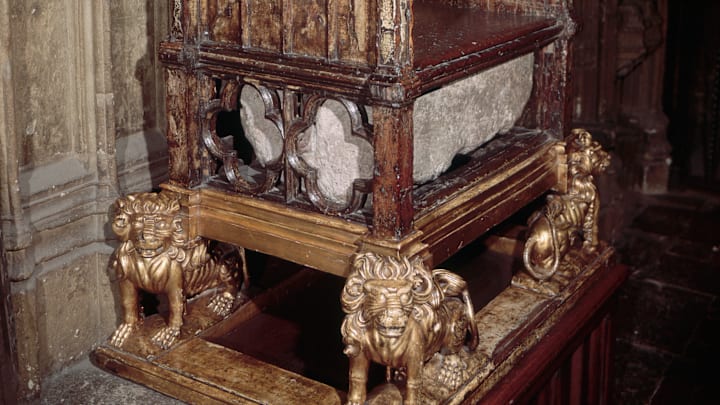Numerous symbols of the British monarchy, including the Crown Jewels, will be on full display at King Charles III’s coronation on May 6, 2023. They include the Stone of Scone, also known as the Stone of Destiny, one of the oldest—and the least glamorous—of the coronation trappings. It’s also the heaviest. A large, rectangular block of sandstone with iron rings attached at either end, the Stone of Scone weighs 336 pounds and measures 26 inches long, 16 inches wide and 11 inches high.
The Stone of Scone may look unassuming, but it’s had a long and colorful history, right up to the present day.
1. The Stone of Scone has murky origins.

The Stone of Scone’s origins are up for debate. According to legend, the stone served as a pillow for the biblical Jacob when he dreamed of a ladder leading to heaven; it was later taken to Egypt, Spain, and Ireland, where it may have been used in the coronation ceremonies of the ancient Irish kings. From there, the Celtic Scots took the stone with them to Scotland. But geologists say the stone is made of the same sandstone found near the Scottish village of Scone.
The Stone of Scone made its first definitive appearance in history when Kenneth I, the king who united the Scots and the Picts, moved his capital from the western part of the country to Scone in the ninth century and brought the stone to Scone Abbey. The stone was used in the coronation ceremonies of Scottish kings until 1296. That year, England’s Edward I defeated the Scots in the Battle of Dunbar at the start of the First War of Scottish Independence. The king confiscated the Stone of Scone and carted the symbol of Scottish sovereignty back to Westminster Abbey in London.
2. The Stone of Scone became part of the Coronation Chair in the 14th century.
Edward I had the Coronation Chair built between 1300 and 1301 to use in coronation ceremonies. The Stone of Scone is prominently displayed within it: The chair includes a platform beneath the seat to house the stone, a visual reminder of England’s dominion over Scotland.
3. The Stone of Scone was bombed by Suffragettes.

In 1914, members of the suffragette group the Women’s Social and Political Union (WSPU) planted a bomb in Westminster Abbey near the Coronation Chair and the Stone of Scone as part of its militant campaign to gain voting rights for women. The explosion damaged the chair and is believed to be what cracked the stone in half, although that damage wouldn’t be discovered until several decades later.
4. The Stone of Scone was hidden during World War II.

During World War II, the Stone of Scone was hidden in a burial vault in Westminster Abbey to prevent it from being stolen or damaged in a German air raid. Only a handful of people knew its location.
5. Students stole the Stone of Scone in the 20th century.
Four Scottish university students broke into Westminster Abbey and stole the Stone of Scone on Christmas Eve in 1950. The stone broke in two as the students removed it from the abbey, likely due to the damage it sustained years earlier in the suffragette bombing.
Back in Scotland, the students handed the stone off to a political group seeking Scottish self-government. The group had the stone repaired; four months later, they placed it on the altar in the ruins of Arbroath Abbey. It was a meaningful location: The abbey was where Scottish nobles pledged their independence from England in 1320 in a document called “the Declaration of Arbroath.” Police were notified of the Stone of Scone’s reappearance and returned it to Westminster Abbey. The students were not charged. The heist is the subject of the 2008 film, Stone of Destiny.
6. The Stone of Scone was returned to Scotland in 1996.
In 1996, the British government returned the Stone of Scone to Scotland. It can be seen at Edinburgh Castle, along with the crown jewels of Scotland. However, it was agreed that the stone would be brought to Westminster Abbey for coronations.
The organization Historic Environment Scotland is tasked with caring for the Stone of Destiny on behalf of Scotland’s Commissioners for the Safeguarding of the Regalia. In 2020, the Scottish government announced plans to move the Stone of Scone to Perth in 2024 as part of the Perth City Hall refurbishment project.
7. New markings were discovered on the Stone of Scone in 2023.

Earlier this year, scientists using digital technology discovered markings on the Stone of Scone that no one had ever noted before. Historic Environment Scotland commissioned the X-ray fluorescence analysis in advance of the coronation. It found traces of copper alloy on the Stone of Scone’s surface, suggesting that a brass or bronze object may have been placed on it at some point. Markings were also discovered that look like Roman numerals. The analysis additionally allowed scientists to see tool marks and details from the repairs made in 1951 more clearly; they then used the digital information to create a 3D replica of the stone.
